|
I, Nature Boy
Outdoor magazine, October 2000
For PDF format click here
And other divinations from Tom Brown's Tracking, Nature, and
Wilderness Survival School. As told by David Rakoff—Acolyte of the
Standard Class, Master Bowdriller, Sweat Lodge Scaredy-Cat, and Friend to the
Vole Photographs By Charles Gullung
IT IS DIFFICULT in the extreme to construct either a Figure-Four
or Paiute deadfall trap, to say nothing of having them work, in the dark, and in
the rain, at 11 p.m., after 17 hours of lectures and demonstrations, during
which one has already been taught (among other things) the Sacred Order of
Survival—shelter, water, fire, food; how to make rope and cordage from plant
and animal fibers; how to start a fire using a bowdrill; finding suitable
materials for tinder (making sure to avoid the very fluffy and flammable mouse
nest as it may contain hanta virus); how to recognize the signs of progressive
dehydration; how to make a crude filter out of a matted clump of grass; how to
distinguish between the common, water-rich grapevine and the very similar yet
very poisonous Canadian moonseed; how to make a solar still out of a hole
covered with a sheet of plastic (and how to continue the condensation process by
urinating around the hole); and the Apache tradition of honoring those things
one hunts, be they animal, vegetable, or mineral. All of this within the first
day and a half of a Standard Class session at Tom Brown's Tracking, Nature, and
Wilderness Survival School in the wilds of northwestern New Jersey.
|
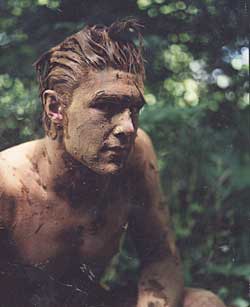
|
A student prepares to stalk prey by "de-scenting" and muddying
up his body to "look like a shadow." |
The Standard is the first and most basic of 28 classes offered by the school,
a Wilderness 101 of sorts—a weeklong, lecture-heavy, intensive introduction to
primitive outdoor skills and nature awareness. The same skills and awareness
found at the very heart of the bildungsroman that is the oft-told life story of
Tom Brown Jr. Briefly, the story is as follows: Growing up in the Jersey Pine
Barrens in the late 1950s, a young Tom spends almost every waking moment from
the ages of seven to 18 in the woods under the tutelage of his best friend
Rick's grandfather, Stalking Wolf, a Southern Lipan Apache from Texas. Brown's
apprenticeship ends in 1967 upon his graduation from Toms River High School. He
is designated 4-F by the draft board due to a chip of obsidian that had lodged
in his right eye in his teens; years earlier, Stalking Wolf is said to have
predicted that a "black rock" would keep the boy out of Vietnam. Over
the next decade Brown takes odd jobs to make the money necessary to spend his
summers testing his skills in unfamiliar environments across the country (the
Tetons, the Dakota Badlands, Death Valley, and the Grand Canyon), living in
debris huts and scout pits of his own devising, and subsisting on food he
forages or kills himself. Eventually the young man re-emerges into society with
a single-minded mission: to teach others and lead them back to the woods and a
love of nature.
There have been digressions along the way. Brown has trained Navy SEALS in
high-speed invisible survival and helped the FBI and state law enforcement
agencies in tracking persons both missing and criminal. He solved his 600th case
on his 27th birthday, a full year before the publication of his first book in
1978. The Tracker is a tale of an adventurous boyhood of limitless
self-reliance in an unfathomably Arcadian wilderness. It makes for compelling,
if not always easy to swallow, reading: part Richard Halliburton, part Carlos
Castaneda, part Kung Fu. Grandfather, already an octogenarian in 1957
when Tom first meets him, appears as a man of almost Buddhalike wisdom with a
penchant for posing oblique, seemingly insoluble riddles and laughing discreetly
behind his hand as Rick and Tom, mired in narrow Western thought, fumble for
answers.
It might not be Thoreau, but it is the key to the legend that Tom Brown may
very well one day become, and certainly already is here at the Tracker School.
Brown, 50, is a cultfigure of international stature. The best-selling author of
16 books, whatever tracking Brown does now, be it for the crooked or the merely
lost, is more of the armchair variety. Having trained tens of thousands of
people at his school, he can call upon a global network of former and current
acolytes when his tracking wisdom is requested.
Many of us here for the Standard—some 90 people from the United States and
Canada, four from Austria, and a young woman all the way from Japan—are
aspirants, yearning to join those ranks of expert trackers. Everyone is
acquainted with Stalking Wolf. All have read at least part of Brown's oeuvre, be
it one of the field guides to wilderness survival or to wild edible and
medicinal plants, or perhaps the more spiritually oriented titles, such as The
Vision, The Quest, The Journey, or Grandfather.
According to the school's statistics, roughly 90 percent of us will return to
take a more advanced course, starting with the Advanced Standard and branching
off thereafter, perhaps to learn Search and Rescue, the Way of the Coyote,
Intensive Tracking, or How to Be a Shadow Scout.
We are diverse in age and gender, and we run the gamut from the pragmatic to
the ethereal; from the unbelievably sweet 18-year-old vegan boy from Portland,
Oregon, to the gun enthusiast who brought his own supply of hermetically sealed
decommissioned military MREs ("Bought 'em on eBay for ten cents on the
dollar after the whole Y2K thing didn't pan out. Best au gratin potatoes I ever
ate"); from the congenial soi-disant "hillbilly from West
Virginia" in his fifties to the twentysomething physics major looking to
drop out for a while. Most are friendly, intelligent, and environmentally and
socially committed. More than a few are involved in education, in particular
working with troubled teens in the wilderness. And, I am relieved to see, most
are refreshingly immune to the pornography of gear. They radiate good health as
they unpack bags of gorp, apples, whole-wheat pitas, and huge water bottles. I,
too, have come prepared—with a deli-size Poland Spring mineral water, assorted
candy bars, and four packs of Marlboro Lights.
I ARRIVE ON APRIL 30, a beautiful, sunny, but very windy Sunday
afternoon. We all spend the first few hours battling the strong breeze to pitch
our tents, the placement of which is overseen by Indigo, one of the eight or so
volunteers, alumni of previous Standard Classes, who help out for the week and
in so doing refresh their skills and relive what was clearly for them a
wonderful experience. Indigo, a rural New Jersey local, hovers somewhere between
50 and 70 years old. With her sun-burnished face, craggy features, and rather
extreme take-charge demeanor, she is straight out of My Antonia. Still,
she's not unfriendly, even as she tells one of the Austrians, his tent staked
down and ready, "Uh-uh, mister. You gotta move it about four inches that
way. We're making a lane right here." Indigo gesticulates like an urban
planner dreaming of a freeway; she is the Robert Moses of Tent City.
|
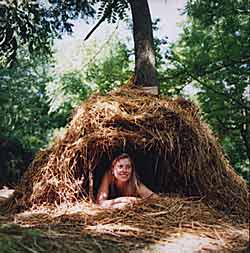
|
|
The indomitable instructor Ruth Ann Colby Martin
practices self-sufficiency in a debris hut |
|
|
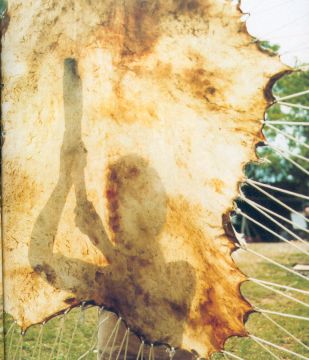
|
|
Tanning a deer hide |
|
It should be noted that we are not actually in the Pine Barrens, sacrosanct
locus of Brown's childhood in and around the town of Toms River. The Standard
Class is held on the Tracker farm in Asbury, New Jersey, near the Pennsylvania
border (not to be confused with Asbury Park, sacrosanct locus of the early
career of that other South Jersey legend, Bruce Springsteen). Brown splits his
time between here and the Barrens, but the farm at Asbury is better for teaching
novices because of its rich biodiversity; the surrounding fields, meadows, and
light forest, and the Musconetcong River, which flows a few hundred yards away,
offer ample flora and fauna for this week of instruction. Aside from the barn,
the central structure where the (hours upon hours of) lectures take place, the
farm consists of Tom Brown's house, a dozen or so portable toilets, and a
toolshed with an awning under which sits a row of chuck-wagon gas rings—our
cafeteria. All activity is centered around the main yard, a scant acre of patchy
lawn that lies between our nylon sleeping quarters and the barn. In the center
of this is the all-important fire, which burns day and night, heating a large
square iron tank with a tap, where we get hot water for our bucket showers.
Brown used to teach the Standard from beginning to end himself. These days,
aside from evening and morning talks, he leaves the teaching responsibilities to
his paid instructors, the most organically charming group of people I've ever
encountered. They're all affable, pedagogically gifted—there isn't a dud
public speaker in the bunch—and chasteningly competent at the endless variety
of primitive skills we're here to learn. They're a lovable crew of commandos
straight out of central casting: Kevin Reeve, 44, director of the school, a John
Goodman paterfamilias type who opted for early retirement from Apple Computer
nine years ago after taking his Standard Class; Joe Lau, 31, resident flint-knapper—his
stone tools are things of beauty—currently ranked second in ninjutsu in the
state of New Jersey; Mark Tollefson, 32, plant expert, wild-edible savant, also
in charge of food; Tom McElroy as the Kid—at 23, youth personified—a
thatch-haired Tom Sawyer with an aw-shucks charm that belies his sniper's aim
with the throwing stick; and Ruth Ann Colby Martin, 26, resident Earth Mother,
who, it seems, can do literally everything, and is polymathically, beatifically
dexterous, capable, strong, beautiful, and funny—Joni Mitchell as Valkyrie.
Even though Ruth Ann has already run the Sandy Hook marathon on the day we meet
her, she fairly glows. Let me be clear: As an avowed homosexual, I make it a
practice to seek out the amorous embraces of men over those of women, and yet I
fall heavily for Ruth Ann.
That first evening, the entire class gathers in the barn for an orientation
session in which we are advised of the school's general guidelines and given our
first taste of the ethos of the place, summed up by Kevin pointing to a sign
above the stage. It reads, "No Sniveling."
"This is a survival school, not a pampering school," Kevin adds. As
if on cue to reiterate the rustic authenticity of the place, a bat that lives in
the barn swoops down over our heads. We are reminded to hydrate regularly and
properly, and to beware the poison ivy that grows rampant on the farm. "And
if you are taking any sort of medication to regulate your moods," Joe tells
us, "we request that you stay on that medication while you're here."
All of the instructors chime in, in unison, their voices weary with hard-won
experience: "We wouldn't say it if it wasn't important."
Finally, we are warned about ticks and their dreaded Lyme disease. We are to
check for the small black dots twice a day all over our bodies, particularly in
those dark, warm, hairy places ticks apparently love. A proper self-scrutiny is
demonstrated by one of the (clothed) volunteers, who takes to the stage holding
a small hand mirror from the shower stalls. He moves it over and around his
torso and limbs like a fan dancer, looking into the glass the whole time. As the
coup de grāce, he shows us how to check our least accessible, most unwelcome
potential Tick Hideout. Turning his back to us, he bends over, bringing the
mirror up between his legs. "Ta-da!" he says, holding a triumphantly
abject position. Everyone applauds.
WE MEET THE MAN HIMSELF the following morning in a welcome lecture of sorts.
Tom Brown is handsome and in great shape. With his silvering hair neatly parted
on the side, trim mustache, and penetrating blue eyes, he resembles nothing so
much as the scary, casually hostile, and emasculating gym teachers of my youth.
|
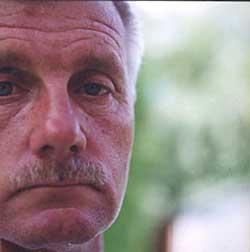
|
The mother hen of all drill sergeants: Author and teacher Tom Brown, hears
a tree calling his name. |
I'm only half right. Brown, while blessed with deadpan comic timing and a
Chautauqua preacher's instinct for the performative flourish, also exhibits a
disquieting and ever-present bass note of dwindling patience. This weird duality
is an acknowledged fact. Kevin has warned us that Brown is "part mother
hen, part drill sergeant." For the uninitiated, it can make for a fairly
bizarre ride, sometimes in the same sentence. He begins with a little flattery,
praising our very presence.
"The terms 'family' and 'brother- and sisterhood' do not fall flippantly
from our lips."
That's nice, we think, prematurely warmed to our cores.
He continues. "Even my parents—when they call, the calls are screened.
I talk to them when I want to. But you," he indicates us, snapping back to
sweetness, "you speak my language. When I say to one of you, 'Hey, I heard
a tree call your name,' you'll know what I mean. You're more than eight-to-five.
I'm an alien out there," he says, meaning society. "But not with you.
You're the warriors."
Happily, the Standard Class is not boot camp. We are not hiked miles and
miles, made to gather firewood for hours on end, or required to test our
physical mettle in any appreciable way. It's more intellectually rigorous. The
days are long, from six in the morning to past 11 at night, largely spent in
lecture, with hands-on experience making up only about 20 percent of our time.
During breaks—primarily the time set aside for meals—we practice our skills.
The yard outside the barn buzzes with pre-industrial activity: people making
cordage, lobbing their throwing sticks at a shooting gallery of plush-toy prey,
fox-walking and stalking slowly across the grass, and trying to start fires with
bowdrills.
This last one is our primary milestone. The squeak of turning spindles and
the sweet smell of smoldering cedar, occasionally followed by the applause of
whatever small group might be standing nearby, is a constant. I make three
attempts before success—but when it comes! The thrill of sawing the drill back
and forth, watching the accumulation of heated sawdust, now brown turning to
black, the thin plume that rises, the gentle coaxing of the tiny coal into
fragile, orange life, the parental swaddling of that ember into a downy tinder
bundle, the ardent, almost amorous gentle blowing of air into same, the curling
smoke, and the final, brilliant burst into flames in one's fingers—its
atavistic high simply cannot be overstated.
Recapturing and maintaining a sense of wonder is at the very heart of the
Tracker School philosophy, which is in part "to see the world through
Grandfather's eyes." In other words, in a state of complete awareness,
living in perfect harmony with nature, attuned to what is known in the Apache
tradition as The Spirit That Moves Through All Things. This awareness will
provide the key to tracking animals, both human and otherwise. "Grandfather
didn't have two separate words for 'awareness' and 'tracking,'" Brown tells
us one morning.
No doubt. But Brown's subsequent description of a brief, hundred-yard morning
walk from his house to the barn is so strange and omniscient, he calls to mind
Luther and Johnny Htoo, the chain-smoking 12-year-old identical twin leaders of
the Karen people's insurgency movement in Burma, with their claims of
invisibility and imperviousness to bullets: "There had been a fox. The
hunting had not gone well. She emerged at 2:22 a.m. Her left ear twitches.
Another step, now fear, and suddenly the feral cat appears. She's gone!" We
won't be able to reach this level by week's end, but apparently, we are told
frequently by both Brown and the instructors, we will be able to "track a
mouse across a gravel driveway."
"FULL SURVIVAL," in Tom Brown's world, has nothing to
do with the amassing of alarming quantities of canned food, a belief that the
government is controlled by Hollywood's Jewish power elite, home schooling, CBS
reality-based programming, or Charlton Heston. Full survival means naked in the
wilderness: no clothes, no tools, no matches. It is both worst-case scenario and
ultimate fantasy. Worst case being that the End Days have come upon us, the
skies bleed red, the Four Horsemen of the Apocalypse have torn up the flower
beds, and we must fend for ourselves and our loved ones. The fantasy being that
we've gotten so sick and tired of our consumer society that we just park our
cars by the side of the highway, step into the woods, and disappear. An
oft-repeated joke throughout the week is, "Next Monday, when you go in to
work and quit your jobs..."
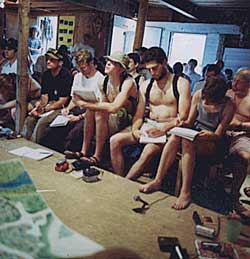 |
Class in session in the barn |
Being in the woods, we are told, will become an experience akin to being
locked in the Safeway overnight. "The main danger in full survival is
gaining weight," Kevin avers. Nature is a bounteous paradise for those who
play by the rules. That would be nature's rules, not the government's. Since
much of the nation's remaining wilderness falls under the protective
jurisdiction of the National Park Service—whose rangers don't look kindly on
the wanton building of debris huts, and killing and eating the animals—much of
what we learn turns out to be illegal in what remains of wild nature.
Case in point: animal skinning. Even picking up roadkill requires a permit.
On Tuesday evening, for the lecture on skinning and brain-tanning, Ruth Ann
comes in wearing a fringed buckskin dress that she made herself. She tells us
the story of coming upon a roadkill buck while taking a much-needed break from
writing college papers. My immediate reaction the entire week to anything Ruth
Ann tells me is eagerness and a wish to try whatever it is she is proposing.
When she tells us how to slit the animal down the middle, and then to cut around
the anus and genitals, and then to pull them through from inside the body
cavity, I think, regretfully, "I wish I had a dead animal's anus and
genitals to cut around and pull through its body cavity."
I almost get my wish. She dons a pair of rubber gloves, leaves the barn, and
comes back bearing a very dead road-killed groundhog. It has already been gutted
and the fur pulled down from the hind legs to just below the rib cage. She hangs
it on a nail by its Achilles tendons. Grabbing hold of the pelt, instructor Tom
McElroy—the Kid—pulls, using his entire body weight. Groundhogs, as it turns
out, have a great deal of connective tissue. There is a ripping, Velcro-like
sound as the fur comes down. McElroy briefly loses his grip and the wet animal
jerks on its nail, spraying students in the front row with droplets of
groundhoggy fluid. The bat flutters around the barn throughout.
Next comes the tanning. Almost nothing is better at turning rawhide into
supple leather than the lipids in an animal's own brain, worked into the skin
like finger paint. A further, utterly beautiful economy of nature is the fact
that every single animal has just enough brains to tan its own hide. Ruth Ann
made her own wedding dress from unsmoked buckskin, as well as her husband's
wedding shirt. She has brought them to the lecture to show us. I expect her to
look rough-hewn, disinhibited, and slightly tacky—like Cher—but when she
takes the dress out of the box and holds it up against herself, it is lovely:
soft, ivory, and impeccably constructed. My crush is total.
But there will be time for infatuation tomorrow. It is getting late, and as
happens every night, my ragestarts to set in around 10:45 when people refuse to
stop asking questions. I'm desperate to get to bed, having concluded my
approximately two and a half hours' worth of obsessively running to the can
during breaks—prophylaxis against a groggy stumble through Tent City to the
Porta-Johns in the middle of the freezing-cold night. A small cadre of exhausted
fugitives has already disappeared, heading back to their tents slowly and
silently, without flashlights. I join them.
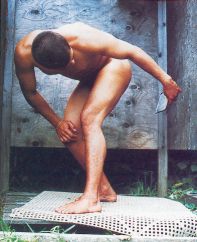 |
A twice-daily tick check is recommended |
AWARENESS STARTS small. Only when we understand the many
mysteries that lie within the earth's tiniest, seemingly mundane details will we
be able to track animals or people. "Awareness is the doorway to the
spirit, but survival is the doorway to the earth. If you can't survive out there
naked and alone, then you're an alien," Brown says one morning, gaining
volume as he goes. "You think the earth is going to talk to someone who is
not one of her children?" he yells.
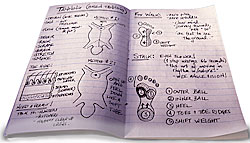 |
Not a pampering school: The conscientious author took 150 pages of notes
during lectures. |
My guess is no. To that end, we are taken out to a meadow overgrown with
heavy grasses, garlic mustard, and wild burdock, a place known as Vole City for
its large population of small rodents. We each lie down and examine an area no
larger than a square foot, digging down, exploring.
My classmates look very idyllic and French Impressionist, scattered about
here and there, supine in the sunlight, lost in contemplative investigation.
Myself, I sit up, terrified at the prospect of finding anything, especially a
vole. The instructorshows me how to root around just underneath the grass to
find their ruts. I use a stick to gingerly push aside the stalks and turn over
the debris, picking out the dull sheen of a slug here, the progress of a tiny
worm there. Thankfully, no voles. Warming to my task, I suddenly spy—dark,
wet, and gray against the fresh green of a blade of grass—the unmistakable
articulation of amphibian digits, a hand span no bigger than this semicolon; it
is connected to a tiny amphibian arm, connected to a tapered amphibian head the
size of a peppercorn. The gleaming, dead eye catches the sunlight. My heart in
my mouth, I call the instructor back over and show him. He picks up the tiny
sprig with the half-eaten salamander still perched on it and holds it four
inches from his mouth, enumerating the various classifications of the creature:
the coloring, the reticulations, the patterns, the species. The instructor
tries, God bless him, to draw me into a Socratic dialogue, asking me questions
about what I've observed. He points to the chewed-out underside of the demi-lizard.
"What kind of teeth marks made those cuts? Are the edges scalloped? Look at
the gnaw marks. That's a great find," he concludes, patting me on the back.
I show my salamander to those working near me in the field, and they show me
what they've uncovered. I feign interest in one woman's small mound of
unidentifiable animal scat. But we both know the truth: My corpse makes her find
look like, well, a pile of shit. For a brief moment, I am Big Man in Vole City.
The instructor's matter-of-fact treatment of the dead salamander, the
complete lack of any "poor little guy" moral component to its demise,
speaks to what makes the Tracker philosophy unique. There is none of that
falsely benign conception of nature as friendly, inherently good, tame, and
prettified. Aldous Huxley, in his essay "Wordsworth in the Tropics,"
assails what he calls the Anglicanization of nature, the cozy revisionism of a
force that is intrinsically alien and inhospitable: "It is fear of the
labyrinthine flux and complexity of phenomena...fear of the complex reality
driving [us] to invent a simpler, more manageable, and, therefore, consoling
fiction."
At Tom Brown's Tracker School, there is a clear-eyed acknowledgment that
things eat and get eaten. Ruth Ann, in telling us of the year she lived in the
Pine Barrens in a house she made entirely by hand with cedar walls and a debris
roof, gets straight to the point. "Whatever came into my house, I
ate," she says. "Mice? We just threw 'em in the fire, burned the hair
off, and ate them whole. They just taste like meat, and there's something to be
said for that added crunch."
She's not being heartless; in fact, she's the very opposite. For every skill
we are taught, whether it's harvesting plants, using our bowdrills, skinning an
animal, or gathering forest debris, the first step in our instruction is always
a moment of thanksgiving for the trees, the spirit of fire, the groundhog, the
water. It's a strange adjustment to have to make, at first. I am not proud to
admit that there was a moment at 5:30 a.m. on the fourth day of class when,
serving on cook crew, I stood bleary-eyed with exhaustion—having only gotten
to bed some five hours earlier because of a late-night lecture on wild
edibles—and seriously considered killing the guy who led us in a 15-minute
thanksgiving that included complimenting the rising sun for being "just the
perfect distance away from us."There are worse things than acknowledging a
continuum and connection between all things and staying mindful and grateful of
our place therein, but it can be a hard concept to swallow before the coffee
hits the system.
Even wide awake there are moments of fuzzy logic in this theory of
interconnectivity. Kevin, our elder statesman, explains that the Apache
tradition of being thankful to the prey will also result in a willing
acquiescence on the part of the hunted. "Something that gives its life for
your benefit does so with gladness, if you are humble," he intones. Isn't
it pretty to think so. Ascribing complicit suicidal motives to the rabbit who
licks the peanut butter from a deadfall bait stick—no matter how
self-effacingly daubed on—seems a tad Wordsworthian to me.
But such doubts become ever fewer as the week progresses. From about Thursday
on, the home stretch of the course, spirits are high. Most of us have gotten
fire, and in a brilliant bit of Pavlovian pedagogy, the food improved markedly
after the outdoor cooking demonstration. Despite the staff's urging us not to
take what we are told at face value, to go home and prove them right or prove
them wrong, we're all pretty jazzed and itching to head out into nature. That
said, among the people I talk to there is also a growing skepticism about Brown
himself. It has nothing to do with his credibility, the veracity of his life
story, or even the purity of purpose of the Tracker School. Unfortunately, it's
personal: Brown's drill sergeant persona thoroughly throttles his mother hen. As
pleasant as he may be just after breakfast—and he frequently is sunny,
sprightly, and very funny—if he addresses us after sunset, there is a darkness
in him and a potential for ire that is frankly terrifying.
In one evening lecture, he talks about the necessity for us to "take
bigger pictures," to see more of the world through our wide-angle vision,
to sense things before actually seeing them. "Instead of going click,
click, click," he minces, "go CLICK! CLICK! CLICK!" he suddenly
roars. A few people actually flinch. Later on, in a moment meant to chide us for
the persistence of our citified tunnel vision, he tells us that he has been
observing us unseen from a perch on top of the tool shed. As we make our way to
bed, we watch our backs, scanning our surroundings for heretofore unnoticed
surveillance. One young man asks the group softly, "You guys ever see Apocalypse
Now?"
IT'S TOO BAD THAT Brown the Personage has this effect on some
people, because when I interview Brown the Person on Friday afternoon, the
next-to-last day of class, he turns out to be a nice, intelligent guy with an
undeniably noble and admirable mission in life. "It would be my dream to go
back into the bush and live and never have to face another aspect of
society," he tells me as we sit at the kitchen table in front of a stone
fireplace. "But that's not my vision, that's my dream. My vision is to
reach as many people as I possibly can." Still, he remains adamant about
not franchising the Tracker School despite huge enrollment. (Before Standard
Classes swelled to close to 100 people, the waiting list was six years.)
By the time I meet him, though, my disenchantment has become fairly
entrenched. It doesn't help that Kevin escorts me into the modest house that
Brown shares with his second wife, Debbie, 33, and their two young
children—and doesn't leave, joining Tom McElroy, who is sitting in a chair,
weaving a jute bag on a small circular loom. They crack jokes, weigh in with
opinions, engage in quiet conversations with one another; the phone rings; they
pour themselves coffee. Pretty soon I realize I've come to the teacher's lounge.
Or is it a convocation of disciples? I ask Brown about the cult of
personality that seems to be part of the Standard Class.
"Oh, I try to get rid of that real quick," he says. "I tell
people right off, 'Don't thank me, thank Grandfather.' I'm a poor example. I am
nobody's guru." Brown talks about how he, Kevin, Ruth Ann, and the crew
have to make sure to keep "Tracker groupies"—those over-enthusiastic
few who try to volunteer just a little too often—at a healthy distance.
"Boy, this would be very easy to turn into a cult, big-time," he
admits, "and I just will not allow it to happen. That's the last thing I
want to happen."
Noted. And yet, in almost every lecture, there is the requisite prefatory
story from Brown's life: "When Tom was 12 years old, Grandfather told him,
'This is the year you will provide me with meat...'" The accrual of
personal detail forms a gospel of sorts, and anecdotes are delivered in a
hortatory, liturgical style. Granted, the stories are told to show the wisdom of
Stalking Wolf, not Tom Brown, but the reflected glory of playing Boswell to
Grandfather's Johnson (a term straight out of a traveling salesman joke) clearly
has its attractions.
Attractions not callously exploited, it seems. There is no line of Tom Brown
sportswear, no exhortation from Brown that I buy anything while I am there, that
I "Think Different." At a very manageable 600 bucks for a week of food
and instruction, the Tracker School is not the enterprise of the career
opportunist. In person, Brown is not only not power-mad, but he comes
across as almost as nice as one of his instructors.
I leave the house fairly won over. I return to Tent City and walk out into
the field to gaze at the sun, now lowering in the late afternoon sky. I find one
of my classmates standing in the grass in the honeyed light, enjoying a water
bottle full of herbal tea. We stand there amiably and peacefully, mutually
imbued with the soy milk of human kindness. He holds out the bottle of amber
liquid, offering it to me, and says, "Rum?"
OUR LAST SUPPER is one of our own harvesting. I'm on burdock detail, digging
the rough, brown, footlong roots out of the red clay of a nearby field with a
fellow student. Back at the cooking shed in the main yard, all 90of us spend an
hour or so cleaning, scraping, and slicing. I have never had a meal so Edenic in
its profusion and beauty: a salad of chickweed, violet flowers, pennycress, and
wild onions; a stir-fry of burdock, dandelion, nettles, and wintercress buds;
dandelion flower fritters; garlic mustard pesto over whole-wheat pasta
(store-bought—cut us some slack); nettle soup; and spicebush tea. We are each
given a trout to gut, wrap in burdock leaves, and place in the fire. After six
days here, I approach this task with a strange relish. It is the best fish I
have ever eaten.
The grand finale of the Standard is a nighttime sweat lodge. I generally try
to avoid pitch-dark, infernally hot enclosures, but now that Brown is my new
best friend I find his preamble so avuncular and sweet that I almost consider
it. He tells us we are to enter in a clockwise direction, leaving the area
behind him free for those among us who suffer claustrophobia. "The minute
you want to get out, just say so and we'll open the doors," he proclaims.
"I won't love you any less."
I resolve to do it until he cedes the floor to Joe Lau, the ninjutsu expert,
who reads us the guidelines. When I hear "crawl in on your hands and
knees," I realize that there is not Xanax enough in the world to make me
enter the low, round, straw-covered structure. The other rules include taking
off all metal jewelry that doesn't sit directly against your skin as it can heat
up, swing back, and burn you pretty badly. And then there's the final
admonition: "You are absolutely forbidden to pass wind in the sweat
lodge," says Joe. "We wouldn't say it if it wasn't important."
The students assemble in their bathing suits, and there is something strange
and primal about this nearly naked crowd in the moonlight. Their progress into
the lodge is slow, and it takes a while for everyone to crawl in. I can hear
Brown beginning his incantatory singing.
I rise early on the last morning. I'm almost the only student awake. I ask if
there's anything I can do, and one of the volunteers asks me to build up the
fire. "Well, how the hell am I supposed to do that?" I think to
myself. Almost as quickly, I realize I know precisely how to do that, and much
more. I have never taken in more information in one week in my life. Can I track
a mouse across a gravel driveway? I couldn't track a mouse across a cookie sheet
spread with peanut butter, but that's no matter. Despite Kevin's recantation in
his final wrap-up, when he begs us, "Don't quit your jobs, don't
make any radical decisions for the next three months, don't trash your
relationships..." ("How many of us did that?" Ruth Ann
stage-whispers), I can't help feeling like I could if I needed to, and survive.
Lavishly.
Another student gives me a lift to the bus station. I count the roadkills on
the shoulder of the highway along the way. "I could do something with
that," I think. "And that. And that." I resist the temptation to
ask my driver to pull over and let me out, so that I may part the trees and step
through, letting the branches close behind me as I keep walking, until I can no
longer be seen from the road.
Reproduced from
http://web.outsideonline.com/magazine/200010/200010natureboy1.html
Copyright Outdoor Magazine (Mariah Media Inc.) |

